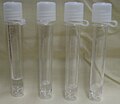Difference between revisions of "CSF cytopathology"
Jump to navigation
Jump to search
| Line 12: | Line 12: | ||
==Normal== | ==Normal== | ||
*Paucicellular. | *Paucicellular. | ||
**Acellular specimens common and considered adequate.<ref>Mody. | **Acellular specimens common and considered adequate.<ref>{{cite book |author=Mody, Dina R. |title= [https://www.amazon.ca/Diagnostic-Pathology-Cytopathology-Dina-Mody/dp/1931884552/ Diagnostic Cytopathology] |publisher=Elsevier Canada |location= |year=2018 |pages= {{{1|II-3 2}}} |edition=1st |isbn=978-1931884556 |oclc= |doi= |accessdate=}}</ref> | ||
*protein is around 15-40 mg/dl | *protein is around 15-40 mg/dl | ||
Gobs of anuclear material: | Gobs of anuclear material: | ||
Revision as of 18:03, 2 May 2024
CSF cytopathology is a subset of CNS cytopathology, which is a subset of cytopathology.
This article deal only with cerebrospinal fluid (CSF) cytopathology. An introduction to cytopathology is in the cytopathology article.
In many institutions, CSF specimens get triaged/rapidly assessed as:
- They are small specimens ~ usually 1-10 ml.
- The procedure to obtain them is non-trivial, i.e. not pleasant for the patient and not risk free.
- Lymphoma is a common malignancy of malignancies found in the CSF.
In many institutions, all CSF specimens are stat.
Cerebrospinal fluid
Normal
- Paucicellular.
- Acellular specimens common and considered adequate.[1]
- protein is around 15-40 mg/dl
Gobs of anuclear material:
- Protein vs. white matter.
- Ocassionally arachnoid cap cell-
Bark-like flaky material:
- Contaminant.
Fluffy/smudged large cells (~2-3x RBC dia.) with an indistinct nucleus:
- Degenerated white cells.
- Should prompt a comment about "degeneration", if the population is dominant.
Routine processing
- Cytospin - if no abnormality at triage.
- The cellularity of the cytospin will appear to be increased (artifact).
Images
Hemorrhage
- Xanthochromatous specimen
Cytology
- Mostly RBC.
- Neutrophils can be increased.
- +/-Erythro- and Siderophages (usu. after 3-4d).
Acute bacterial meningitis
Main article: Meningitis
Cytology
- Neutrophils - none should be present normally.[4][5]
- If the tap is traumatic (i.e. fibrin is present) the finding may be uninterpretable.
- Neutrophils may be present in early exsudative phase of viral meningitis.
- Cell count usually above 1000/µl.
DDx:
- TBC
- Fungal meningitis
Viral meningitis
Main article: Meningitis
General
- Positive viral culture.
- HSV
- CMV
- Enterovirus
- HIV
Cytology
- Pleocytosis (usu. 10-1000 cells/µl).
- Polymorphous population of lymphocytes.[4]
- Activated lymphocytes.
- Plasma cells (sometimes bi- and multinuclear).
- Occ. mitoses.
- Activated (vacuolated) monocytes.
Mollaret's meningitis
General
- Rare aseptic meningitis.
- Suspected to be caused by HSV1 and HSV2.[6]
Clinical:
- Recurrent meningismus, headache, +/-fever.[6]
Cytology
Features:
- Mollaret cells - described as monocytoid cells[4] (look like monocytes[7] - but do not phagocytose), and large endothelial cells.[6]
- Features - large cells with: abundant cytoplasm, footprint-shaped" nucleus.
- Mollaret cells not pathognomonic.[6]
- Mixed population of inflammatory cells[4] (PMNs, monocytes, plasma cells, lymphocytes); usually lymphocyte predominant.[6]
Image:
Meningeosis neoplastica
CNS lymphoma
Histology:[4]
- Too many cells - key feature.
- Not diagnostic... but should raise suspicion.
- Single cells (as typical of lymphoma/leukemia).
- Large lymphocytes - >2x RBC diameter.
- +/-Nuclear atypia.
- Radial segmentation - a completely cleaved nucleus/quasi-binucleation.
Notes:
- Massive karyorrhexis (nuclear fragmentation) is suggestive of lymphoma[4] - not common.
Meningeal carcinomatosis (Meningeosis carcinomatosa)
Histology:
- abnormal cell size / giant multinuclear cells.
- unusual nuclear/cytoplasm ratio.
- hyperchromatic nuclei.
- prominent nucleoli.
- atypical mitoses.
- cell clustering.
Notes:
- cell count can be normal.
- accompanied by granulocytes and monocytes.
Non-lymphoid, non-epithelial neoplasm
- Non-lymphoid, non-epithelial neoplasms are rarely found in the CSF.
- Ependymomas and medulloblastomas have a higher rate of dissemination than other primary brain tumors.
Meningeosis gliomatosa (Astrocytoma/Glioblastoma):
- May vaguely resemble a neuroendocrine tumour:
- Small cell clusters.
- Nuclear moulding.
- Cells somewhat larger than small cell carcinoma.
- Scant cytoplasm.
CNS fungal infections
- Cryptococcus is the most common.[8]
Cryptococcosis
Main article: Cryptococcosis
- AKA cryptococcus infection
General
- Usu. immunocompromised host.
Microscopic
Microscopic appearance:
- Yeast:[8]
- Round/ovoid 5-15 micrometres.
- Thick mucopolysacchardie capsule + refractile centre.
- "Target-like" shape/"bull's eye" appearance.
- "Tear drop-shapped" budding pattern (useful to differentiate from Blastomyces, Histoplasma).
Images:
- Cryptococcus in lung FNA - Field stain (WC).
- Crytococcosis - mucicarmine stain (WC).
- Crytococcosis - methenamine silver stain (WC).
See also
References
- ↑ Mody, Dina R. (2018). Diagnostic Cytopathology (1st ed.). Elsevier Canada. pp. II-3 2. ISBN 978-1931884556.
- ↑ Liggett, SB.; Berger, JR.; Hush, J. (Aug 1982). "Cerebrospinal fluid xanthochromia with rifampin.". Ann Neurol 12 (2): 228-9. doi:10.1002/ana.410120240. PMID 7125611.
- ↑ Bremer, HL. (May 1985). "Identification of xanthochromia.". JAMA 253 (17): 2496. PMID 3981778.
- ↑ 4.0 4.1 4.2 4.3 4.4 4.5 Lefkowitch, Jay H. (2006). Anatomic Pathology Board Review (1st ed.). Saunders. pp. 681 (Q25). ISBN 978-1416025887.
- ↑ MUN. 4 November 2010.
- ↑ 6.0 6.1 6.2 6.3 6.4 http://emedicine.medscape.com/article/1169489-overview
- ↑ http://www.mondofacto.com/facts/dictionary?monocytoid+cell
- ↑ 8.0 8.1 Lefkowitch, Jay H. (2006). Anatomic Pathology Board Review (1st ed.). Saunders. pp. 682. ISBN 978-1416025887.















